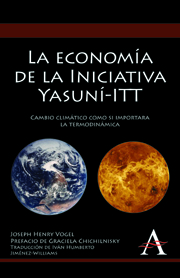Book contents
- Frontmatter
- Contents
- Comentarios del traductor
- Prólogo
- Prefacio
- Introducción
- Agradecimientos
- Abreviaciones y siglas
- Capítulo 1 La termodinámica
- Capítulo 2 La tragedia de los comunes
- Capítulo 3 La ignorancia voluntaria de la realpolitik
- Capítulo 4 La teoría general del segundo mejor
- Capítulo 5 A través del cuello de botella de una economía de vaquero
- Conclusiones
- Apéndice: Filmografia anotada de YouTube
- Notas
- Índice
Capítulo 5 - A través del cuello de botella de una economía de vaquero
Financiación de proyectos ya preparados
Published online by Cambridge University Press: 05 June 2012
- Frontmatter
- Contents
- Comentarios del traductor
- Prólogo
- Prefacio
- Introducción
- Agradecimientos
- Abreviaciones y siglas
- Capítulo 1 La termodinámica
- Capítulo 2 La tragedia de los comunes
- Capítulo 3 La ignorancia voluntaria de la realpolitik
- Capítulo 4 La teoría general del segundo mejor
- Capítulo 5 A través del cuello de botella de una economía de vaquero
- Conclusiones
- Apéndice: Filmografia anotada de YouTube
- Notas
- Índice
Summary
La teoría no transcurre dentro del vacío. Los economistas reflexionarán sobre John Maynard Keynes y la Gran Depresión. Keynes observó que los mercados no siempre operan en concordancia con lo que la teoría económica había observado durante años. Por ejemplo, un tercio de la fuerza laboral de los EE.UU. afrontaba el desempleo en la década de 1930. En lugar de los precios, las cantidades se ajustaron y la economía se asentó en un equilibrio de desempleo. Mediante la incorporación de esta observación a la teoría, surgió la macroeconomía. En la actualidad, existe aun más razón que nunca para creer que la teoría no puede ocurrir dentro del vacío. Según Stern, las fluctuaciones climáticas pueden causar estragos que al combinarse superarán aquellos causados por la Gran Depresión y las guerras de la primera mitad del siglo XX. ¿Llegará a surgir una nueva macro-macroeconomía? El meollo de mi argumento es esta ya surgió. A mediados de 1970, una nueva macro-macroeconomía podía ser espigada en la economía de Boulding, Georegescu Roegen, Schumacher y Daly, y la ciencia de Carson, Ehrlich, Hardin y Prigogine. Diez años es un lapso razonable para poner en práctica la síntesis. Si el aparato político hubiera tomado medidas a mediados de los 80, el ejemplo de Stern de “cambio climático” como el fallo del mercado… en la mayor escala que el mundo jamás haya visto” habría sido mitigado en gran medida o incluso evitado.
- Type
- Chapter
- Information
- La economía de la Iniciativa Yasuní-ITTCambio climático como si importara la termodinámica, pp. 61 - 82Publisher: Anthem PressPrint publication year: 2012



